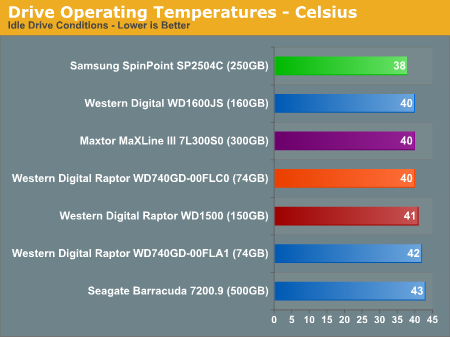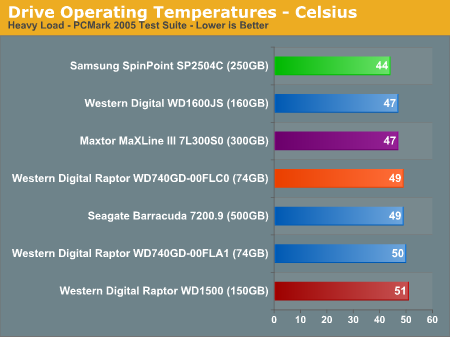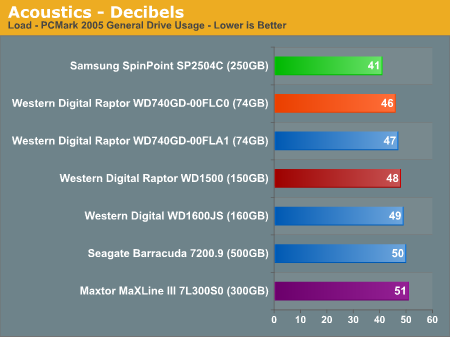Western Digital WD1500ADFD: King Raptor
by Gary Key on February 8, 2006 1:30 AM EST- Posted in
- Storage
Hard Drive Performance: Thermal and Acoustics
We have revised our acoustics testing for this article. Our acoustic test utilizes our standard test bed components, but we installed our Thermaltake water-cooling system for the CPU and turned off the case fans to isolate as much case noise as possible during testing. Our OCZ power supply is virtually silent in these tests and we installed our fanless Gigabyte 6600GT video card to further reduce noise.
Our acoustic tests are designed to measure the decibel levels while the system is at idle and also under load while running the General Hard Disk Drive Usage benchmark within PCMark 2005. We found through trial and error that this particular benchmark produces controlled readings across a wide range of applications within the benchmark. This particular benchmark utilizes 60% reads and 40% writes within the trace playback file.
The measurements are taken at a distance of 5 millimeters from the rear and front of the drive being tested in order to minimize surrounding environmental noise. The reported measurements are based on an A-weighted decibel score that measures frequencies similar to the way that the human ear responds to sound. We take a total of 5 measurements for each test. We subtract the high and low scores and then average the middle three to arrive at our findings.
Our thermal tests continue to utilize sensor readings via the S.M.A.R.T. technology on the drives. We will move to an infrared thermometer testing procedure in the near future to supplement the current test procedures.
Our favorite drive for HTPC work, the Samsung SP2504C, leads the group in both thermals and acoustics. The drive was virtually silent throughout our testing and would make an excellent drive for silent systems.
The thermal characteristics of both Raptors were very close with the WD1500 running slightly hotter under the load conditions. While we did not report the infrared test results in this article, the heat sink fan area on the Raptors reached temperatures around 55c during the load testing. Of course, these temperatures would be reduced with the case fans running, but it is something to be aware of if you plan on utilizing the drive in a SFF case.
The acoustical characteristics of both Raptors were similar. You will notice a slight whine during the spin-up phase on each drive along with the same whine when the drive powers down. The reads are clearly audible, but do not have the same metallic noise that we noticed on the Maxtor drives. During normal operations, both drives could be heard, but the sounds emitting from the drive was almost dull compared to the Maxtor drives. The WD1500 was slightly louder during constant read access compared to the WD740GD. While not obtrusive in our opinion, the sound levels would be clearly evident in a silent system.
We have revised our acoustics testing for this article. Our acoustic test utilizes our standard test bed components, but we installed our Thermaltake water-cooling system for the CPU and turned off the case fans to isolate as much case noise as possible during testing. Our OCZ power supply is virtually silent in these tests and we installed our fanless Gigabyte 6600GT video card to further reduce noise.
Our acoustic tests are designed to measure the decibel levels while the system is at idle and also under load while running the General Hard Disk Drive Usage benchmark within PCMark 2005. We found through trial and error that this particular benchmark produces controlled readings across a wide range of applications within the benchmark. This particular benchmark utilizes 60% reads and 40% writes within the trace playback file.
The measurements are taken at a distance of 5 millimeters from the rear and front of the drive being tested in order to minimize surrounding environmental noise. The reported measurements are based on an A-weighted decibel score that measures frequencies similar to the way that the human ear responds to sound. We take a total of 5 measurements for each test. We subtract the high and low scores and then average the middle three to arrive at our findings.
Our thermal tests continue to utilize sensor readings via the S.M.A.R.T. technology on the drives. We will move to an infrared thermometer testing procedure in the near future to supplement the current test procedures.




The thermal characteristics of both Raptors were very close with the WD1500 running slightly hotter under the load conditions. While we did not report the infrared test results in this article, the heat sink fan area on the Raptors reached temperatures around 55c during the load testing. Of course, these temperatures would be reduced with the case fans running, but it is something to be aware of if you plan on utilizing the drive in a SFF case.
The acoustical characteristics of both Raptors were similar. You will notice a slight whine during the spin-up phase on each drive along with the same whine when the drive powers down. The reads are clearly audible, but do not have the same metallic noise that we noticed on the Maxtor drives. During normal operations, both drives could be heard, but the sounds emitting from the drive was almost dull compared to the Maxtor drives. The WD1500 was slightly louder during constant read access compared to the WD740GD. While not obtrusive in our opinion, the sound levels would be clearly evident in a silent system.










51 Comments
View All Comments
shady28 - Sunday, April 9, 2006 - link
Kinda bogus review here. How on earth can you put a SATA drive in comparison to other SATA drives, then draw conclusions about SATA vs SCSI?? The answer is you can't, especially in regards to SATA being 'ready' for use in big fileservers. It's a cheap alternative to SCSI, not a performance alternative. Check the link below for fileserver iometer (IOPs) benchmarks of many different drives, and you'll find that the top SCSI drives demolish the top SATA drives with nearly double the IOPs ratings :
http://www.storagereview.com/comparison.html">http://www.storagereview.com/comparison.html
Kensei - Friday, February 10, 2006 - link
I've said it before but I'll say it again... Gary sets the standard for technical writing excellence. His work should be studied closely by all who aspire to do this type of work. I hope you're at least 26 or older becasue if you're writing like this at 19, 20 or 21, I think I'm going to get sick... with jealousy.Kensei
SpecOps - Friday, February 10, 2006 - link
I would have liked to see the "value Raptor" in the tests as well, so we can get a better picture of price vs. performance.Gary Key - Friday, February 10, 2006 - link
I will see if we can get a WD4000 series and update the article or at least have it for the RAID follow up. We have the new WD 500GB drive to test also.JustAnAverageGuy - Thursday, February 9, 2006 - link
Good article Gary, look forward to more in the future.One of the few editors who actually reads and replies to more than just one or two comments. :thumbsup;
- JaAG
CrystalBay - Wednesday, February 8, 2006 - link
Gary , you have a very proficient writing ability . I noticed it on your first review at AT keep up the good work...MadAd - Wednesday, February 8, 2006 - link
I just checked and prices for these in the UK is £210 - its almost the price of a scsi drive ffs (a 147gig hitachi u320 is only £50 more).
Im not quite sure what market segment these are aimed at, I just hope they dont shoot themselves in the foot being priced so close.
yacoub - Wednesday, February 8, 2006 - link
Gary - Thanks for this excellent review and for addressing the two primary complaints I had with the last harddrive review here: The old Samsung drives listed and lack of SP2405C and the tiny decibel test graph that was hard to read and draw conclusions from.This test has a great lineup of drives tested and much better graphs. Very nicely done!
Gary Key - Thursday, February 9, 2006 - link
Thank you and actually everyone for the comments. We have certainly listened to the requests and hopefully our improvements over the course of the next few articles will be satisfactory for everyone.
Although I have had some personal issues with Samung drives in the past I have to give them credit for producing a very good drive in the SP2504c. It would be my drive of choice in a HTPC or SFF setup at this time if you need a silent drive. The performance of the drive is competitive with others in its class for the most part at a very good price point. I tested the drive last night in a sound enclosure and there was only a 5 decibel difference between idle and constant read/write operations. I believe some of the additional decibel readings in the article is our equipment picking up noise from the drive cage. We will continue to refine this process for testing but the readings we reported were very consistent given the environmental conditions in the test room.
Jeff7181 - Wednesday, February 8, 2006 - link
I agree with those that say a Part 2 with RAID testing would be interesting.